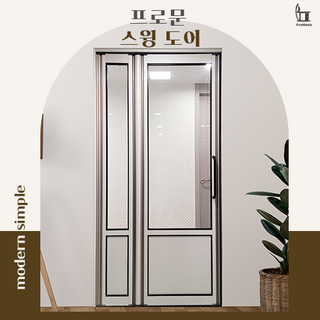
3연동중문 활용법 알아보세요
아이지 중문 3연동 1.4 슬라이딩 친환경 도어의 주요 특징과 상세 스펙을 확인하세요.
아이지 중문 3연동 중문은 현대적인 디자인과 뛰어난 기능성을 자랑하는 제품으로, 누구나 쉽게 활용할 수 있습니다.
주요 특징
이 제품은 친환경 소재로 제작되어 환경과 건강을 고려한 안전한 선택입니다. 3연동 기능으로 공간 활용이 뛰어나며, 집안의 분위기를 한층 더 고급스럽게 만들어 줍니다.
상품 스펙
| 항목 | 세부 스펙 |
|---|---|
| 상품명 | 아이지 중문 3연동 1.4 슬라이딩 친환경 도어 |
| 재질 | 투명 접합유리 / 민자우드 고시 / 펄화이트우드 |
| 크기 | 1.4m (슬리밍 초슬림 미닫이) |
| 가격 | 상담 후 문의 (현재 할인 중) |
| 배송 | 로켓배송 |
| 평점 | ⭐0.0 (리뷰 없음) |
이 제품이 마음에 드신다면 여기를 클릭하여 자세한 정보를 확인하세요.
설치 전 확인해야 할 점
모두홈도어 3연동중문으로 환하게 밝혀진 현관!
여러분, 저도 처음 중문을 설치할 때 고민 많이 했어요. 설치하기 전에 꼭 확인해야 할 몇 가지가 있습니다!
상품 사용 경험
주요 장점
- 친환경 소재 - 모두홈도어는 알루미늄으로 제작되어 견고하면서도 친환경적입니다.
- 슬림한 디자인 - 초슬림형(20BAR)으로 공간을 더욱 넓게 느끼게 해줘요.
- 투명 유리 - 유리분할형 디자인으로 통유리처럼 시원한 느낌을 제공합니다.
활용 방법
이 상품을 활용하는 방법은 매우 다양해요:
- 가장 먼저, 자신이 살고 있는 아파트 현관의 너비(1801~2100mm)를 정확히 측정해보세요.
- 설치 위치를 결정하기 위해 주변 분위기와 인테리어를 고려해보세요.
- 마지막으로, 설치 업체에 요청할 때 미리 디자인 취향을 전달해 원하는 스타일로 설치할 수 있도록 하세요.
지금 상품을 할인된 가격으로 만나보세요! 여러분의 집도 이렇게 아름다워질 수 있어요!
지금 바로 디자인하세요
하부레일 없는 3연동 수동중문으로 세련된 공간을 만들어보세요.
이 상품의 핵심 특징을 확인해보세요!
상품 특징
- 디자인: 슬림한 형태로 공간을 더욱 넓게 보이도록 해주는 초슬림 디자인
- 편리함: 하부레일이 없어 청소가 쉽고 이동이 간편함
- 다양한 활용: 아파트, 빌라, 주택, 사무실, 병원, 카페 등 다양한 공간에 적합
사용 방법
- 설치 위치를 정한 후, 중문을 수직으로 세워 고정합니다.
- 문을 부드럽게 밀어 닫아보며 레일이 헛돌지 않도록 조정합니다.
- 필요에 따라 문을 열고 닫는 방향을 설정하세요.
활용 팁
- 문 색상과 인테리어 스타일에 맞춰 조화롭게 배치하세요.
- 추가적인 장식 품목과 함께 조화를 이루면 더욱 멋진 공간이 됩니다.
- 정기적으로 문을 청소하여 항상 깨끗한 상태를 유지하세요.
지금 상품을 할인된 가격으로 만나보세요!
사용 팁을 기억하세요
프리미엄 상품을 통해 이런 고민을 해결할 수 있습니다.
이런 고민, 이제 해결해드립니다!
실제 사용자의 경험담: "이 제품을 사용하고 나서 더 이상 그런 문제로 고민하지 않게 되었어요."
자주 겪는 문제들
- 이웃의 소음: 집안에서 조용히 하고 싶어도 이웃의 소음이 신경 쓰이는 경우가 많습니다.
- 공간 활용: 중문이 없어서 공간이 좁게 느껴져 불편한 상황이 발생할 수 있습니다.
- 미관 저하: 현관의 문이 오래되고 낮은 퀄리티로 미관이 저하되는 경우.
해결 방법
- 3연동중문: 프로문 현관중문 중문 스윙도어를 설치하여 소음을 차단하고, 조용한 공간을 만들어 줍니다.
- 공간 활용 최적화: 3연동중문으로 오픈할 수 있는 공간을 극대화하여 더욱 넓은 느낌을 줍니다.
- 고급스러운 디자인: 세련된 디자인으로 현관의 미관을 크게 개선시켜 줍니다.
지금 상품을 할인된 가격으로 만나보세요!
효과적인 관리 방법 익히세요
프로문 현관중문 중문 스윙도어의 주요 특징과 장점을 확인하세요.
이 상품의 특별한 장점을 확인해보세요!
상품 특징 비교
- 세련된 디자인 - 프로문 현관중문은 집안의 고급스러움을 더해줍니다.
- 내구성 - 고급 소재로 제작되어 오랜 사용이 가능하며, 관리가 용이합니다.
- 스윙도어 기능 - 편리한 개폐 방식으로 누구나 쉽게 사용할 수 있습니다.
다른 제품과의 차이점
- 경량 설계 - 타 중문에 비해 가벼우면서도 견고하여 설치가 수월합니다.
- 5.0의 높은 별점 - 많은 사용자들이 극찬하는 품질과 성능입니다.
- 다양한 색상 옵션 - 고객의 취향에 맞는 다양한 색상으로 제공됩니다.
구매 시 고려사항
- 설치 공간 - 제품의 크기를 고려하여 적절한 공간에 설치해야 합니다.
- 가격 - 현재 저렴한 가격에 만나볼 수 있으니 혜택을 놓치지 마세요!
- 후기 확인 - 여러 사용자의 후기가 참조하여 구매 결정을 도와줍니다.
지금 상품을 할인된 가격으로 만나보세요!



